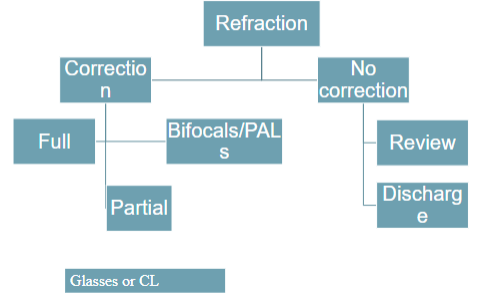refractive errors July 2025
1/24
There's no tags or description
Looks like no tags are added yet.
Name | Mastery | Learn | Test | Matching | Spaced |
|---|
No study sessions yet.
25 Terms
Emmetropisation components
Passive emmetropisation
Active emmetropisation
Visually driven mechanism
Nature
Genetics
Ethnicity
Family history
Heredity is not destiny
Myopia: is the nature-nurture debate finally over
Nurture
Myopia:
Major increase in recent years – epidemic proportions
Reading in the dark
Too much close work
Lack of sunlight
?evidence of change in hypermetropia
close work
In Singapore myopia increased from 25 to 80% in 18 yr old
males over 30 yr period
BUT 70% of 18yr old men of Indian origin living in Singapore
have myopia – compared to 10% in India
Myopia and close work
Saw 2002 Arch Ophthalmol
Books read per week
High myopia >3D 4.3±5.8
Low myopia 2.6±2.5
Emmetropia 2.5±2.2
Daylight and myopia
More near work linked to less time outdoors
Seasonal variation
Daylight linked to release of dopamine, involved in eye growth regulation
methods of reducing myopia
manipulation of optics
bifocals
varifocals
undercorrection
contrast management
corneal reshapping
RGP CLs
ortho-K
Prevention of accom
atropine
environmental
time outdoors
contrast management
near activities
Contrast management
Genetics have shown:
L or M cone photopigment gene mutations associated with abnormally
high retinal contrast signalling & highly progressive myopia
Increased stimulation of retinal contrast pathway in CSNB is associated
with high myopia
Reduced contrast signalling in achromatopsia is associated with
hypermetropia
Clinical observations
High contrast visual activities and environments associated with
progressive myopia
dark text on a white background
Digital devices
Modern urban environments
Atropine
By preventing accommodation, eliminates stimulus for eye
growth
• Can reduce/halt eye growth
• BUT what are disadvantages?
• Reducing strength of eye drops 0.01%
Treatment options
Acupuncture – for myopia
light therapy
eye massager
Hypermetropia
ALSPAC
Hypermetropia (and associated conditions) commoner in children with
fewer socio-economic advantages
Not explained by BW, GA, perinatal illness or FH
MEPEDS & BPEDS
Hypermetropia significantly more common when primary care givers
education less than high school
Impact of hypermetropia
Williams 2005
Significantly lower education scores in children aged 8 yrs
with >+3DS
Higher rates requiring referral to educational psychologist
Roch-Levecq 2008
Spectacle correction improved results on visual motor
integration tasks (but only 14% hypermetropic >+4DS)
VIP study 2016
Uncorrected hyperopia ≥4.0 D or hyperopia ≥3.0 to ≤6.0 D
associated with reduced binocular near VA (20/40 or worse)
or reduced near stereoacuity (240 seconds of arc or worse) in
4- and 5-year-old children enrolled in preschool or
kindergarten is associated with significantly worse
performance on a test of early literacy.
Detection of hypermetropia
homson software Vision Screener
Why +2.50DS?
Is this level appropriate for all ages?
How long should you allow?
What response warrants referral?
reduced prescription for hypermetrop
giving full amount
Best VA
Risk of preventing
emmetropisation
But already impacted in the
presence of strabismus
reduced
May not attain maximum VA
May be better tolerated
undercorrecting hypermet
Under corrected by 1DS at nine months vs children with
hypermetropia who were not treated
Evaluation between 9 and 36 months showed no significant
difference
BUT there was considerable individual variation which could
not be accounted for
Atkinson et al 2000
Impeding emmetropisation
Refractive error ≥+5.25D in one eye at 6 months + wore
their glasses
Emmetropisation significantly impeded compared to
those who did not wear their glasses
BUT emmetropisation not halted
Ingram et al 2000
Majority of change in refractive error occurs during 1st
yr of life
So ? wait to prescribe until after 1yr of age
Lack of evidence
Exceptions to the rule
strabismus
downs syndrome
premature
Hypermetropia & strabismus
RCT
Children with gls
MSE did not decrease
Children who developed strabismus
MSE did not change whether in gls or not
Ingram et al 2000
Change in refractive status was not related to early refractive
status
BUT age at follow up during the period when
emmetropisation is incomplete.
So we do not know if the strabismus resulted in
Slower/delayed development of eye growth
Long term impact
Changes in refractive error in patients with accommodative
esotropia after being weaned from hyperopic correction BJO
2014
Anisometropia and strabismus
In strabismic patients the mean change in refraction was less
in the fellow than fixing eye
Aniso increased in 53% of strabismics but remained
unchanged in 94% of straight eyes
evidence
Srabismus
Suggests full correction should be given due to lack of
emmetropisation
BUT data grouped eg all ET’s and low number of XT’s –
does one rule apply to all?
Downs syndrome
Suggests full correction should be given because of poor
accommodation
BUT may not be required long term
LBW
Suggests give some correction
BUT no comparison of with/without glasses
Long term outcomes in hypermetropia
Jaycock Ophthalmology 2005
5 yrs post LASIK
If initial ref error +1.00 to +3.00 D 71.0% of eyes within +/-1.00 D of
intended correction
Initial ref error +3.5 to +6.0 D 37.5% of eyes within +/-1.00 D of
intended correction
Paediatric refractive surgery
Minority of patients
Uses?
Challenges
Target refraction
Patient cooperation
High refractive errors
Who are the minority?
Spectacle non-compliant
With amblyogenic anisometropia
Bilateral ametropia exceeds 4-5D
Children with special needs
Eg significant craniofacial or ear deformities, hearing aids, a cochlear
implant etc
summary
Lack of standardisation of a significant refractive error
But is it possible/appropriate to standardise?
Evidence based practice
Still many areas lacking in evidence eg emmetropisation and
strabismus
Prescribe or wait and see?
Weigh up pros and cons
How much weight do we give to each factor
